Salón de Reinos
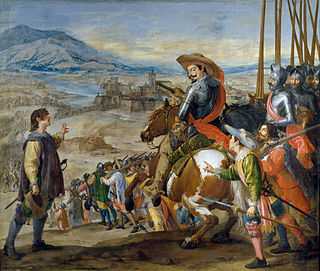
The Salón de Reinos (Hall of the Kingdoms) or salón grande (great hall) is a wing of the Buen Retiro Palace in Madrid. Built between 1630 and 1635, it housed the largest paintings in the royal collection, now all in the Museo del Prado. It is named after its paintings of the coats of arms of the 24 kingdoms which formed the Kingdom of Spain at the time of Philip IV of Spain. It was also known as the Museo del Ejército, after the museum housed in it until 2010, when that museum's collections were moved to the Alcázar of Toledo. The Salón de Reinos and the Casón del Buen Retiro are the only survivors of the original grand scheme of the palace.
Decoration of the room
Originally intended as a place from which the king could watch and assist in theatrical productions in the courtyard, the Salón de Reinos was turned into a throne room when it was decided to turn Buen Retiro into a full palace. It was still used for spectacles and soirees, so a balcony was added so that festivities could be viewed from above, but as a throne room it had to impress ambassadors and other distinguished members of the courts of Europe who visited the palace. This meant the room's decoration was the most sumptuous in the whole palace, well-illuminated by several windows between jaspers tables and silver lions and with a ceiling covered in grotesques. There were also wall paintings full of political symbolism with the ultimate aim of glorifying Philip IV. The designer of the room's decorative programme is unknown, though ultimate responsibility lay in the hands of the conde duque de Olivares himself, along with Jerónimo de Villanueva (who gave the lions and effected the payments) and with the intellectual advice of Francisco de Rioja and of the painters closest to Philip and Olivares, Juan Bautista Maíno and Velázquez.
The Salón de Reinos is rectangular in plan, with narrow doors on the two longer sides. On its north and south sides hung twelve paintings (one now lost) on the theme of the major battles won by the armies of Philip IV in the early years of his reign. Between these paintings, and above the Salón's windows, were ten paintings by Zurbarán showing the labours of Hercules, comparing the exploits of the demi-god Hercules (then considered as the ancestor of the House of Habsburg) with those of the king.
The battle paintings juxtaposed examples by artists of the older generation such as Vicente Carducho or Eugenio Cajés (who had both served Philip III of Spain) with ones by younger artists trained in naturalism such as Juan Bautista Maíno, Zurbarán (summoned from Seville for this very commission), Jusepe Leonardo, Félix Castelo (who did his first major work there), Antonio de Pereda and especially Velázquez, Philip IV's favourite.
At the east and west ends were portraits by Velázquez of the royal family. The series was made up of equestrian portraits of Philip III and his wife Margaret of Austria (both on the west all) and equestrian portraits of Philip IV and his wife Elisabeth of France either side their son and heir Balthasar Charles (all three on the east wall). These five paintings' distribution and staggered positioning exemplified the concepts of hereditary monarchy and dynastic continuity.
Based on the titles held by Philip IV, the hall also contained shields showing the coats of arms of the twenty-four kingdoms that made up his kingdom: in alphabetical order, Algarbe, Algeciras, Aragón, Castilla, Cerdeña, Dos Sicilias, Galicia, Gibraltar, Granada, Indias Orientales y Occidentales, Islas de Canarias, Islas y Tierra firme del Mar Oceano, Jaén, Jerusalén, León, Murcia, Navarra, Portugal, Sevilla, Toledo and Valencia. (Philip IV also held the titles of Archduke of Austria, Duke of Burgundy, Duke of Brabant, Duke of Milan, Count of Habsburg, Count of Flanders, Count of Tyrol, Count of Barcelona and Lord of Vizcaya and of Molina.)
Paintings
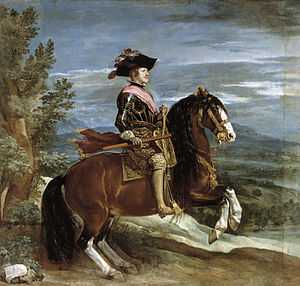
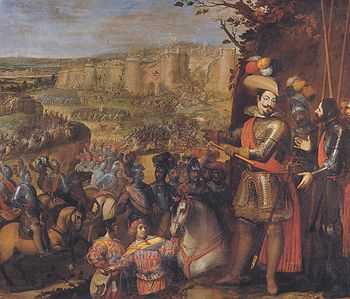
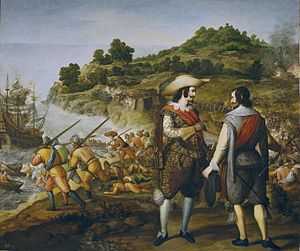
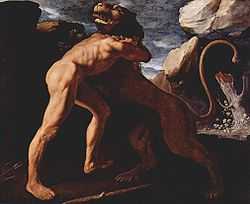
The layout of the portraits and battle paintings in the Salón, based on the reconstruction produced by Jose Alvarez Lopera, which is in turn based on the Silva topográfica by Manuel de Gallegos and the 1701 inventory, is as follows:
West wall (main entrance)
Three works by Velázquez:
- Equestrian Portrait of Philip IV
- Equestrian Portrait of Elisabeth of France
- Equestrian Portrait of Prince Balthasar Charles
East wall (behind the throne)
- Equestrian Portrait of Philip III, by Velázquez and workshop
- Equestrian Portrait of Margarita of Austria, by Velázquez
North wall
- The expulsion of the Dutchmen from the island of San Martin by the Marquis of Cadreita, by Eugenio Cajés (lost).
- The capture of Rheinfelden by Vincent Carducho. Oil on canvas (297 x 357 cm), Museo Nacional del Prado.
- The Relief of Brisach by Jusepe Leonardo. Oil on canvas (304 x 360 cm), Museo Nacional del Prado.
- The relief of the Plaza de Constanza, Vicente Carducho. Oil on canvas (297 x 374 cm), Museo Nacional del Prado.
- The recovery of the island of Puerto Rico by Don Juan de Haro, Eugenio Cajés . Oil on canvas (290 x 344 cm), Museo Nacional del Prado.
- The recovery of the island of San Cristobal by Don Frederic of Toledo, Felix Castelo. Oil on canvas (297 x 311 cm), Museo Nacional del Prado.
South wall
- The Recovery of Bahia by Juan Bautista Maino . Oil on canvas (290 x 370 cm), Museo Nacional del Prado.
- The Relief of Genoa by the second Marquis of Santa Cruz, by Antonio de Pereda y Salgado. Oil on canvas (290 x 370 cm), Museo Nacional del Prado.
- The victory at Fleurus, by Vicente Carducho. Oil on canvas (297 x 365 cm), Museo Nacional del Prado.
- The surrender of Juliers by Jusepe Leonardo. Oil on canvas (307 x 381 cm), Museo Nacional del Prado.
- The Surrender of Breda, by Diego Velázquez. Oil on canvas (307 x 367 cm), Museo Nacional del Prado.
- The defense of Cadiz against the English, by Zurbarán. Oil on canvas (302 x 323 cm). Museo Nacional del Prado.
Trials of Hercules
Over the windows were paintings of the trials of Hercules by Zurbarán, all 130 cm x 160 cm, all oil on canvas, all now in the Prado:
- Hercules and the Cretan bull.
- Hercules's struggle with Antaeus.
- Hercules' struggle with the Erymanthian boar.
- Hercules diverting the river Alpheus.
- Hercules and Cerberus.
- Hercules wrestling with the Nemean lion.
- Hercules fights the Hydra of Lerna.
- Hercules closes the straits of Gibraltar.
- Hercules kills king Gerion.
- Death of Hercules.
Later history
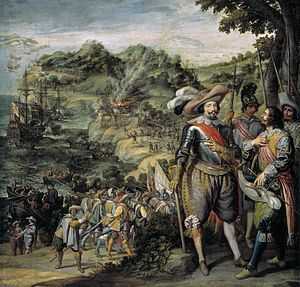
The Salón de Reinos, and the Salón de Fiestas (now the Casón del Buen Retiro) were the only parts of the palace to survive the intense French bombardment between 1808 and 1814 during the Peninsular War and the appearance of the buildings were transformed by post-war rebuilding.
For a long time the Salón de Reinos housed the Museo del Ejército. In the early 21st century the Spanish Ministry of Culture launched a series of studies and reforms to move the museum to a larger, better and more modern setting at the Alcázar of Toledo, giving over the Salón de Reinos over to the Prado, which already had responsibility for the Casón and which could then return the Salón de Reinos to its 17th-century appearance and reinstate the paintings originally meant for it. This would be all the easier since the wall paintings, ceiling paintings and grotesques were still well preserved, but the initial proposal caused a debate on the building's final use, with some opposing it since it would separate works by Velázquez such as The Surrender of Breda from his other works in the Prado, and others since they felt that such a move was unjustified just to recreate a single room. The final option taken was to give over the Salón de Reinos and its adjoining rooms to various activities such as temporary exhibitions or exhibiting medium-quality items which there is now room to display in the Prado. The tender for the work was expected to be granted in 2009 or 2010, with the works occurring from 2010 to 2012, with a budget of 42.5 million Euros.[1] The Museo del Ejército reopened in Toledo in July 2010, though the works on the Salón de Reinos require more time.
References
- ↑ (Spanish) EFE (5-2-2009). «El Plan del Prado prevé culminar su nueva ampliación». La Opinión de Zamora (Editorial Prensa Ibérica). Consulted 16-7-2009.
Bibliography
- (Spanish) PÉREZ SÁNCHEZ, Alfonso E. (1992). Pintura barroca en España 1600-1750. Madrid : Ediciones Cátedra. ISBN 84-376-0994-1.
- (Spanish) BROWN y J. H. ELLIOT, Jonathan (1985). Un palacio para el rey. El Buen Retiro y la corte de Felipe IV. Madrid : Alianza Editorial. ISBN 84-292-5111-1.
- (Spanish) GARRIDO PÉREZ, Carmen (1992). Velázquez. Técnica y evolución. Madrid : Museo del Prado. ISBN 84-87317-16-2.
- (Spanish) LÓPEZ TORRIJOS, Rosa (1985). La mitología en la pintura española del Siglo de Oro. Madrid : Cátedra. ISBN 84-376-0500-8.
- (Spanish) Corpus velazqueño. Documentos y textos (2000), Madrid, Ministerio de Educación, Cultura y Deporte, ISBN 84-369-3347-8
External links
![]() Media related to Salón de Reinos at Wikimedia Commons
Media related to Salón de Reinos at Wikimedia Commons